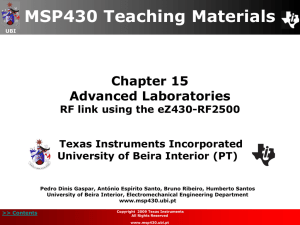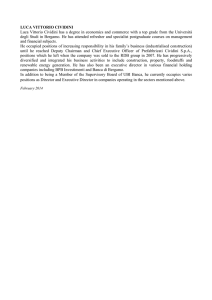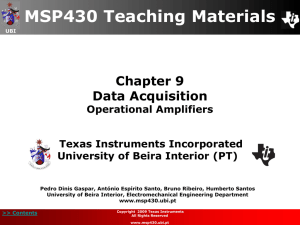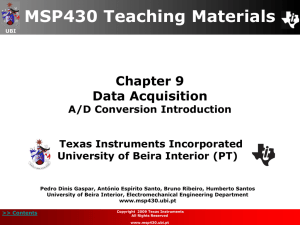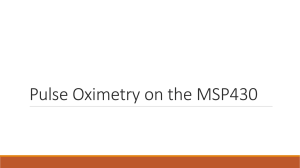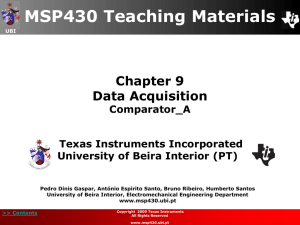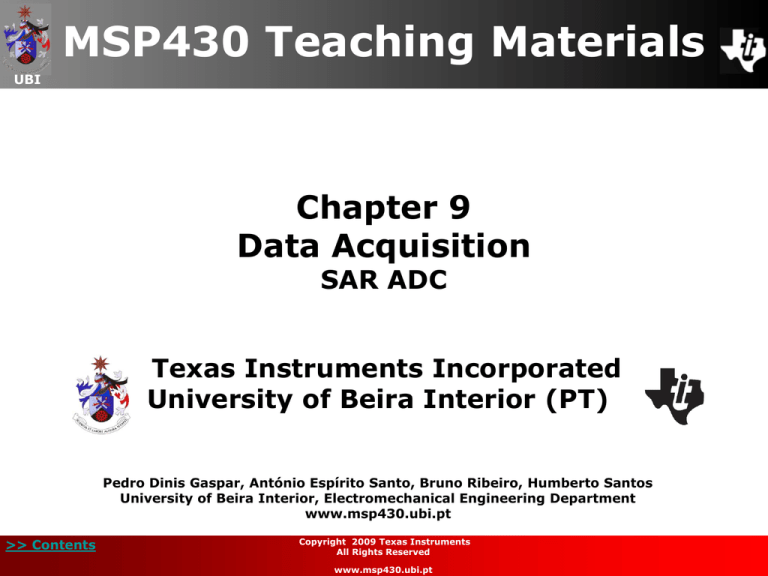
MSP430 Teaching Materials
UBI
Chapter 9
Data Acquisition
SAR ADC
Texas Instruments Incorporated
University of Beira Interior (PT)
Pedro Dinis Gaspar, António Espírito Santo, Bruno Ribeiro, Humberto Santos
University of Beira Interior, Electromechanical Engineering Department
www.msp430.ubi.pt
>> Contents
Copyright 2009 Texas Instruments
All Rights Reserved
www.msp430.ubi.pt
Contents
UBI
Introduction to Successive Approximation Register
(SAR) Analogue-to-Digital Converter (ADC)
ADC10
ADC12
Laboratory 5: Signal Acquisition
Lab5A: SAR ADC10 conversion
LAB5B: SAR ADC12 conversion
Quiz
>> Contents
Copyright 2009 Texas Instruments
All Rights Reserved
www.msp430.ubi.pt
2
Introduction to SAR ADC (1/4)
UBI
Successive Approximation Register (SAR) converters are
well-suited to general purpose applications and are used in
a wide range signal interfacing applications:
Data loggers;
Temperature sensors;
Bridge sensors (resistive e.g. strain gauges);
General purpose.
>> Contents
Copyright 2009 Texas Instruments
All Rights Reserved
www.msp430.ubi.pt
3
Introduction to SAR ADC (2/4)
UBI
SAR block diagram:
>> Contents
Copyright 2009 Texas Instruments
All Rights Reserved
www.msp430.ubi.pt
4
Introduction to SAR ADC (3/4)
UBI
SAR concept:
Determines the digital word by approximating the analogue
input signal using an iterative process, as follows:
•
•
•
•
•
>> Contents
Discharge the capacitor array to the comparator’s Voffset;
Sample the input voltage (VS) and hold;
Switch all of the capacitors in the array to VS;
Switch the capacitors to charge the comparator's input;
Initiate a binary search:
– Switch the MSB capacitor to VREF (ADC’s FS range):
» Divided 1:1 between it and the rest of the array;
» Input voltage to the comparator is - VS + VREF/2;
» VS > VREF/2 Comparator output: MSB = 1;
» VS < VREF/2 Comparator output: MSB = 0;
– Switch the other capacitors in a decreasing charge
capacity order from 16C to C.
Copyright 2009 Texas Instruments
All Rights Reserved
www.msp430.ubi.pt
5
Introduction to SAR ADC (4/4)
UBI
SAR concept:
>> Contents
Copyright 2009 Texas Instruments
All Rights Reserved
www.msp430.ubi.pt
6
ADC 10
UBI
ADC10:
Introduction
Features
10 bit ADC core
Conversion clock
Sample and conversion timing
Conversion modes
Data Transfer Controller (DTC)
Integrated temperature sensor
ADC10 interrupts
Registers
>> Contents
Copyright 2009 Texas Instruments
All Rights Reserved
www.msp430.ubi.pt
7
ADC10 (1/2)
Description
UBI
The ADC10 module of the MSP430F2274 supports fast 10bit analogue-to-digital conversions;
The module contains:
– 10-bit SAR core;
– Sample select control;
– Reference generator;
– Data transfer controller (DTC) for automatic conversion
result handling (ADC samples conversion and storage
without CPU intervention).
>> Contents
Copyright 2009 Texas Instruments
All Rights Reserved
www.msp430.ubi.pt
8
ADC10 (2/2)
Description
UBI
ADC10 block diagram:
>> Contents
Copyright 2009 Texas Instruments
All Rights Reserved
www.msp430.ubi.pt
9
ADC10
Features
UBI
Greater than 200 ksps maximum conversion rate;
Monotonic 10-bit converter with no missing codes;
Sample-and-hold with programmable sample periods;
Conversion initiated by software or Timer_A;
Software on-chip reference voltage generation (1.5 V or 2.5 V)
Software selectable internal or external reference;
Eight external input channels;
Conversion channels for internal temperature sensor, VCC, and
external references;
Selectable conversion clock source;
Single-channel, repeated single-channel, sequence, and repeated
sequence conversion modes;
ADC core and reference voltage (powered down separately);
Data transfer controller (automatic storage of results).
>> Contents
Copyright 2009 Texas Instruments
All Rights Reserved
www.msp430.ubi.pt
10
ADC10
10 bit ADC core
UBI
10 bit ADC core (enable with ADC10ON bit):
Converts an analogue input to its 10-bit digital representation;
Stores the result in the ADC10MEM register;
The analogue conversion range is limited by the upper and
lower limits: VR+ ; VR The digital output (NADC) is:
– Full scale: NADC = 03FFh, when the input signal VR+ -0.5LSB;
– Zero: NADC = 0000h, when the input signal VR- + 0.5 LSB.
Conversion results:
V VR
• Binary format: N ADC 1 0 2 3 in
VR VR
• Two’s-complement format.
>> Contents
Copyright 2009 Texas Instruments
All Rights Reserved
www.msp430.ubi.pt
11
ADC10
Conversion clock
UBI
The ADC10CLK is used both as the conversion clock and to
generate the sampling period;
Each available ADC10 source clock is selected using the
ADC10SSELx bits:
SMCLK;
MCLK;
ACLK;
Internal oscillator ADC10OSC;
Each clock source can be divided from 1-8 (ADC10DIVx bits).
The ADC10CLK must remain active until the end of a
conversion.
>> Contents
Copyright 2009 Texas Instruments
All Rights Reserved
www.msp430.ubi.pt
12
ADC10
Sample and conversion timing
UBI
An A/D conversion is initiated by the rising edge of SHI.
The sources of SHI (SHSx bits selection) can be:
ADC10SC bit;
Timer_A Output Unit 1, Output Unit 0, or Output Unit 2.
The SHTx bits select the sample period, tsample, to be 4, 8,
16, or 64 ADC10CLK cycles:
>> Contents
Copyright 2009 Texas Instruments
All Rights Reserved
www.msp430.ubi.pt
13
ADC10 (1/2)
Conversion modes
UBI
Conversion modes (selected by the CONSEQx bits):
Single channel, single-conversion: A single conversion for
the channel selected by INCHx bits is performed, with the
result being stored in the ADC10MEM registers;
Sequence of channels: One conversion in multiple channels,
beginning with the channel selected by INCHx bits and
decrementing to channel A0, looping through a specified
number of ADC10MEM registers and stopping after the
conversion of channel A0.
>> Contents
Copyright 2009 Texas Instruments
All Rights Reserved
www.msp430.ubi.pt
14
ADC10 (2/2)
Conversion modes
UBI
Conversion modes (selected by the CONSEQx bits):
Repeat single channel: A single channel selected by INCHx
bits is converted repeatedly until stopped and the result is
stored in the ADC10MEM register;
Repeat sequence of-channels: Repeated conversions for
multiple channels, beginning with the channel selected by
INCHx bits and decrementing to channel A0. Each ADC result is
written to ADC10MEM. The sequence ends after conversion of
channel A0, and the next trigger signal re-starts the sequence.
>> Contents
Copyright 2009 Texas Instruments
All Rights Reserved
www.msp430.ubi.pt
15
ADC10 (1/2)
Data Transfer Controller (DTC)
UBI
DTC (ADC10DTC1 0):
Automatically transfers the conversion results from ADC10MEM
to other on-chip memory locations each time the ADC10
completes a conversion and loads the result to ADC10MEM.
Requires one CPU MCLK:
If the CPU is active during this period, it will be halted to
ensure the transfer is completed;
Ensure that no active conversion or sequence is in progress
(ADC10 busy) during DTC transfer initiation.
>> Contents
Copyright 2009 Texas Instruments
All Rights Reserved
www.msp430.ubi.pt
16
ADC10 (2/2)
Data Transfer Controller (DTC)
UBI
The Data Transfer Controller (DTC) can be configured for:
One-Block Transfer Mode (ADC10TB = 0):
• The value n in ADC10DTC1 defines the total number of
transfers for a block;
• First block address range
{Start: ADC10SA; End: ADC10SA+2n–2};
Two-Block Transfer Mode (ADC10TB = 1):
• The value n in ADC10DTC1 defines the number of transfers
for one block;
• First block address range
{Start: ADC10SA ; End: ADC10SA+2n–2};
• Second block address range:
{Start: SA+2n ; End: SA+4n–2}.
>> Contents
Copyright 2009 Texas Instruments
All Rights Reserved
www.msp430.ubi.pt
17
ADC10
Integrated temperature sensor
UBI
Input channel selected as INCHx = 1010;
Transfer function relating the input voltage, VTemperature [V]
to the temperature, T [ºC], is given by:
VTemperatur e 0.0 0 3 5 5
T 0.9 8 6
Considerations:
• The sampling period must be greater than 30 μs;
• Large offset error, must be calibrated;
• Automatically turns on the on-chip reference generator.
>> Contents
Copyright 2009 Texas Instruments
All Rights Reserved
www.msp430.ubi.pt
18
ADC10
ADC10 interrupts
UBI
One interrupt and one interrupt vector are associated with
the ADC10 function:
When the DTC is not used (ADC10DTC1 = 0): ADC10IFG is set
when conversion results are loaded into ADC10MEM;
When DTC is used (ADC10DTC1 > 0): ADC10IFG is set when a
block transfer completes and the internal transfer counter
n = 0.
When ADC10IE = 1 and GIE = 1, the ADC10IFG flag
generates an interrupt request.
>> Contents
Copyright 2009 Texas Instruments
All Rights Reserved
www.msp430.ubi.pt
19
ADC10 (1/7)
Registers
UBI
ADC10CTL0, ADC10 Control Register 0 (high byte)
15
14
SREFx
13
12
11
ADC10SHTx
Bit
10
9
8
ADC10SR
REFOUT
REFBURST
Description
15-13
SREFx
Select voltage reference:
SREF2 SREF1 SREF0 = 000
SREF2 SREF1 SREF0 = 001
SREF2 SREF1 SREF0 = 010
SREF2 SREF1 SREF0 = 011
SREF2 SREF1 SREF0 = 100
SREF2 SREF1 SREF0 = 101
SREF2 SREF1 SREF0 = 110
SREF2 SREF1 SREF0 = 111
12-11
ADC10SHTx
ADC10 sample-and-hold time:
ADC10SHT1 ADC10SHT0 = 00 4 x ADC10CLKs
ADC10SHT1 ADC10SHT0 = 01 8 x ADC10CLKs
ADC10SHT1 ADC10SHT0 = 10 16 x ADC10CLKs
ADC10SHT1 ADC10SHT0 = 11 64 x ADC10CLKs
10
ADC10SR
ADC10 sampling rate:
ADC10SR = 0 Reference buffer supports up to ~200 ksps
ADC10SR = 1 Reference buffer supports up to ~50 ksps
9
REFOUT
Reference voltage output (pin VREF+):
REFOUT = 0 Disable
REFOUT = 1 Enable
8
REFBURST
Controls the operation of the internal reference buffer:
REFBURST = 0 Reference buffer on continuously allowing the reference voltage to be present outside the device
continuously.
REFBURST = 1 Reference buffer automatically disabled when the ADC10 is not actively converting, and
automatically re-enabled when during sample-and-conversion.
>> Contents
VR+
VCC
VREF+
VeREF+
Buffered VeREF+
VCC
VREF+
VeREF+
Buffered VeREF+
Copyright 2008 Texas Instruments
All Rights Reserved
www.msp430.ubi.pt
VR−
VSS
VSS
VSS
VSS
VREF−/VeREF−
VREF−/VeREF−
VREF−/VeREF−
VREF−/VeREF−
20
ADC10 (2/7)
Registers
UBI
ADC10CTL0, ADC10 Control Register 0 (low byte)
7
6
5
4
3
2
1
0
MSC
REF2_5V
REFON
ADC10ON
ADC10IE
ADC10IFG
ENC
ADC10SC
Bit
Description
7
MSC
Multiple sample and conversion (Valid for sequence or repeated modes):
MSC = 0 Requires a rising edge of the SHI signal to trigger each sample-and-conversion.
MSC = 1 After the first rising edge of the SHI signal that triggers the sampling timer the further sample-and-conversions are
performed automatically as soon as the prior conversion is completed
6
REF2_5V
Reference-generator voltage select (REFON bit must also be set):
REF2_5V = 0 Reference voltage = 1.5 V
REF2_5V = 1 Reference voltage = 2.5 V
5
REFON
Reference generator:
REFON = 0 Reference generator disable
REFON = 1 Reference generator enable
4
ADC10ON
ADC10 on:
ADC10ON = 0 ADC10 off
ADC10ON = 1 ADC10 on
3
ADC10IE
ADC10 interrupt enable
ADC10IE = 0 Interrupt disabled
ADC10IE = 1 Interrupt enabled
2
ADC10IFG
ADC10 interrupt flag:
ADC10IFG = 0 No interrupt pending (interrupt request is accepted, or it may be reset by software)
ADC10IFG = 1 Interrupt pending (ADC10MEM is loaded with a conversion result or when a block of DTC transfers is completed)
1
ENC
Enable conversion:
ENC = 0 ADC10 disabled
ENC = 1 ADC10 enabled
0
ADC10SC
Start conversion:
ADC10SC = 0 No sample-and-conversion start
ADC10SC = 1 Start sample-and-conversion
>> Contents
Copyright 2008 Texas Instruments
All Rights Reserved
www.msp430.ubi.pt
21
ADC10 (3/7)
Registers
UBI
ADC10CTL1, ADC10 Control Register 1 (high byte)
15
14
13
12
11
INCHx
10
SHSx
Bit
9
8
ADC10DF
ISSH
Description
15–12
INCHx
Input channel select:
INCH3 INCH2 INCH1 INCH0 = 0000 A0
INCH3 INCH2 INCH1 INCH0 = 0001 A1
INCH3 INCH2 INCH1 INCH0 = 0010 A2
INCH3 INCH2 INCH1 INCH0 = 0011 A3
INCH3 INCH2 INCH1 INCH0 = 0100 A4
INCH3 INCH2 INCH1 INCH0 = 0101 A5
INCH3 INCH2 INCH1 INCH0 = 0110 A6
INCH3 INCH2 INCH1 INCH0 = 0111 A7
INCH3 INCH2 INCH1 INCH0 = 1000 VeREF+
INCH3 INCH2 INCH1 INCH0 = 1001 VREF−/VeREF−
INCH3 INCH2 INCH1 INCH0 = 1010 Temperature sensor
INCH3 INCH2 INCH1 INCH0 = 1011 (VCC – VSS)/2
INCH3 INCH2 INCH1 INCH0 = 1100 (VCC – VSS)/2 or A12*
INCH3 INCH2 INCH1 INCH0 = 1101 (VCC – VSS)/2 or A13 *
INCH3 INCH2 INCH1 INCH0 = 1110 (VCC – VSS)/2 or A14 *
INCH3 INCH2 INCH1 INCH0 = 1111 (VCC – VSS)/2 or A15 *
* on MSP430x22xx devices
11–10
SHSx
Sample-and-hold source:
SHS1 SHS0 = 00
SHS1 SHS0 = 01
SHS1 SHS0 = 10
SHS1 SHS0 = 11
9
ADC10DF
ADC10 data format:
ADC10DF = 0 Binary
ADC10DF = 1 Two’s complement
8
ISSH
Invert signal sample-and-hold
ISSH = 0 The sample-input signal is not inverted
ISSH = 1 The sample-input signal is inverted
>> Contents
bit ADC10SC
TIMER_A Output Unit 1
TIMER_A Output Unit 0
TIMER_A Output Unit 2
Copyright 2008 Texas Instruments
All Rights Reserved
www.msp430.ubi.pt
22
ADC10 (4/7)
Registers
UBI
ADC10CTL1, ADC10 Control Register 1 (low byte)
7
6
ADC10DIVx
5
4
3
2
ADC10SSELx
1
CONSEQx
Bit
0
ADC10BUSY
Description
7–5
ADC10DIVx
ADC10 clock divider:
ADC10DIV2 ADC10DIV1
ADC10DIV2 ADC10DIV1
ADC10DIV2 ADC10DIV1
ADC10DIV2 ADC10DIV1
ADC10DIV2 ADC10DIV1
ADC10DIV2 ADC10DIV1
ADC10DIV2 ADC10DIV1
ADC10DIV2 ADC10DIV1
4–3
ADC10SSELx
ADC10 clock source:
ADC10SSEL1 ADC10SSEL0
ADC10SSEL1 ADC10SSEL0
ADC10SSEL1 ADC10SSEL0
ADC10SSEL1 ADC10SSEL0
2–1
CONSEQx
Conversion sequence mode:
CONSEQ1 CONSEQ0 = 00
CONSEQ1 CONSEQ0 = 01
CONSEQ1 CONSEQ0 = 10
CONSEQ1 CONSEQ0 = 11
0
ADC10BUSY
ADC10 busy:
ADC10BUSY = 0 No operation is active
ADC10BUSY = 1 Sequence, sample, or conversion is active
>> Contents
ADC10DIV0
ADC10DIV0
ADC10DIV0
ADC10DIV0
ADC10DIV0
ADC10DIV0
ADC10DIV0
ADC10DIV0
=
=
=
=
=
=
=
=
=
=
=
=
00
01
10
11
000
001
010
011
100
101
110
111
/
/
/
/
/
/
/
/
1
2
3
4
5
6
7
8
ADC10OSC
ACLK
MCLK
SMCLK
Single-channel, single-conversion
Sequence-of-channels
Repeat-single-channel
Repeat-sequence-of-channel
Copyright 2008 Texas Instruments
All Rights Reserved
www.msp430.ubi.pt
23
ADC10 (5/7)
Registers
UBI
ADC10AE0, Analogue (Input) Enable Control Register 0
Enables the analogue input of the ADC10: BIT0 => A0, BIT1
=> A1, and so on.
ADC10AE1, Analogue (Input) Enable Control Register 1
(‘F2274)
Additional analogue input enable control register. BIT4 =>
A12, BIT5 => A13, BIT6 => A14, and BIT7 => A15.
ADC10MEM, Conversion-Memory Register
Loaded with the conversion results;
Numerical result format:
• Binary: Bits 15-10 = 0. The results in the least significant
10 bits.
• 2’s complement: The results in the most significant 10 bits.
Bits 5-0 = 0.
>> Contents
Copyright 2009 Texas Instruments
All Rights Reserved
www.msp430.ubi.pt
24
ADC10 (6/7)
Registers
UBI
ADC10DTC0, Data Transfer Control Register 0
7
6
5
Reserved
4
3
2
1
0
ADC10TB
ADC10CT
ADC10B1
ADC10FETCH
Bit
Description
3
ADC10TB
2
ADC10CT
1
ADC10B1
0
ADC10FETCH
>> Contents
ADC10 block mode:
ADC10TB = 0
One-block transfer mode
ADC10TB = 1
Two-block transfer mode
ADC10 continuous transfer
ADC10CT = 0 Data transfer stops when a block(s) transfer is
completed
ADC10CT = 1 Data is transferred continuously
block filled with ADC10 conversion results (two-block mode):
ADC10B1 = 0 Block 2 is filled
ADC10B1 = 1 Block 1 is filled
Normally set ADC10FETCH = 0
Copyright 2009 Texas Instruments
All Rights Reserved
www.msp430.ubi.pt
25
ADC10 (7/7)
Registers
UBI
ADC10DTC1, Data Transfer Control Register 1
This 8-bit register defines the number of transfers for each
block;
ADC10DTC1 = 0 DTC is disabled;
ADC10DTC1 = 01h−0FFh Number of transfers per block.
ADC10SA, Start Address Register for Data Transfer
This 16-bit register defines the ADC10 start address for the
DTC. It uses only the 15 most significant bits. Bit 0 is always
read as 0.
>> Contents
Copyright 2009 Texas Instruments
All Rights Reserved
www.msp430.ubi.pt
26
Contents
UBI
ADC12
Description
Features
12 bit ADC core
Similarities with ADC10
Sample and conversion timing
Conversion memory
ADC12 interrupts
ADC12 interrupt vector generator
Registers
>> Contents
Copyright 2009 Texas Instruments
All Rights Reserved
www.msp430.ubi.pt
27
ADC12 (1/2)
Introduction
UBI
The ADC12 module of the MSP430F2013 supports fast 12bit analogue-to-digital conversions;
The module contains:
• 12-bit SAR core;
• Sample select control;
• Reference current generator.
>> Contents
Copyright 2009 Texas Instruments
All Rights Reserved
www.msp430.ubi.pt
28
ADC12 (2/2)
Introduction
UBI
ADC12 block diagram:
>> Contents
Copyright 2009 Texas Instruments
All Rights Reserved
www.msp430.ubi.pt
29
ADC12
ADC12 Features
UBI
It has same basic features as the ADC10, with the following
differences:
• Monotonic 12-bit converter with no missing codes;
• Interrupt vector register for fast decoding of 18 ADC
interrupts;
• Registers for storage of 16 conversion results;
• No Data Transfer Controller (DTC);
• 16 control registers ADC12MCTLx for free choice of
channels on sequential modes;
• Can also convert some channels more than once in one loop
(e.g. placing two measurements of the same voltage and
one measurement of current in between to calculate
power).
>> Contents
Copyright 2009 Texas Instruments
All Rights Reserved
www.msp430.ubi.pt
30
ADC12
12 bit ADC core
UBI
12 bit ADC core (enable with ADC12ON bit):
Converts an analogue input to its 12-bit digital representation;
Stores the result in a ADC12MEM register.
The conversion is limited by the upper and lower limits: VR+ ;
VR The digital output (NADC) is:
– Full scale: NADC = 0FFFh, when the input signal VR+;
– Zero: NADC = 0000h, when the input signal VR-.
Conversion results:
• Binary format: N ADC 4 0 9 6Vin VR
VR VR
• Two’s-complement format.
>> Contents
Copyright 2009 Texas Instruments
All Rights Reserved
www.msp430.ubi.pt
31
ADC12
Similarities to ADC10
UBI
Conversion clock selection;
ADC12 inputs and multiplexer;
Analogue port selection (P6);
Voltage reference generator:
For proper operation requires
storage capacitors across
VREF+ and AVSS.
Conversion modes;
Integrated temperature sensor.
>> Contents
Copyright 2009 Texas Instruments
All Rights Reserved
www.msp430.ubi.pt
32
ADC12 (1/3)
Sample and conversion timing
UBI
An A/D conversion is initiated on the rising edge of SHI.
The source for SHI (SHSx bits selection) can be:
ADC12SC bit;
Timer_A Output Unit 1; Timer_B Output Unit 0, or ; Output Unit 1.
ADC12 timer trigger for reference settling:
>> Contents
Copyright 2009 Texas Instruments
All Rights Reserved
www.msp430.ubi.pt
33
ADC12 (2/3)
Sample and conversion timing
UBI
Sample-timing methods:
SHP = 0: Extended sample mode:
• SHI signal directly controls SAMPCON;
• Defines the length of the sample period tsample;
• SAMPCON = 1 sampling is active;
• High-to-Low SAMPCON transition starts the conversion
after synchronization with ADC12CLK.
>> Contents
Copyright 2009 Texas Instruments
All Rights Reserved
www.msp430.ubi.pt
34
ADC12 (3/3)
Sample and conversion timing
UBI
Sample-timing methods:
SHP = 1: Pulse mode:
• SHI signal triggers the sampling timer;
• SHT0x and SHT1x bits (ADC12CTL0) defines the SAMPCON
sample period, tsample;
• The sampling timer keeps SAMPCON = 1 after
synchronization with AD12CLK.
>> Contents
Copyright 2009 Texas Instruments
All Rights Reserved
www.msp430.ubi.pt
35
ADC12
Conversion memory
UBI
16 ADC12MEMx conversion memory registers (configured
by the associated ADC12MCTLx control register) to store
conversion results.
Non-sequential conversion (single- or repeat-singlechannel):
CSTARTADDx define the first and single ADC12MCTLx for
conversion.
Sequential conversion (sequence-of- or repeat-sequenceof-channels):
A sequence is started by the command found in the
ADC12MCTLx register pointed to by CSTARTADDx;
The pointer is incremented automatically to the next
ADC12MCTLx for the next conversion;
After ADC12MCTL15 the next conversion is ADC12MCTL0;
The sequence runs until an EOS bit signals that this command
is the last conversion of the actual sequence;
The 16 ADC12MCTLx registers can contain more than one
sequence.
>> Contents
Copyright 2009 Texas Instruments
All Rights Reserved
www.msp430.ubi.pt
36
ADC12
ADC12 interrupts
UBI
The ADC12 has 18 interrupt sources:
ADC12IFG0-ADC12IFG15: ADC12IFGx bits are set when their
corresponding ADC12MEMx memory register is loaded with a
conversion result;
ADC12OV, ADC12MEMx overflow: ADC12OV is set when a
conversion result is written to any ADC12MEMx before its
previous conversion result was read;
ADC12TOV, ADC12 conversion time overflow: ADC12TOV is set
when another sample-and-conversion is requested before the
current conversion is completed.
The DMA is triggered after the conversion in single channel
modes or after the completion of sequence−of−channel
modes.
>> Contents
Copyright 2009 Texas Instruments
All Rights Reserved
www.msp430.ubi.pt
37
ADC12
ADC12 Interrupt vector generator
UBI
Interrupt vector register ADC12IV used to determine which
enabled ADC12 interrupt source requested an interrupt.
Considerations:
• The highest priority enabled interrupt generates a number
in the ADC12IV register (evaluated or added to the program
counter to automatically call the appropriate routine);
• Any access, read or write, of the ADC12IV register
automatically resets the ADC12OV or the ADC12TOV
conditions, if either were the highest pending interrupt;
• ADC12IFGx bits are reset automatically by accessing their
ADC12MEMx register or may be reset by software;
• If another interrupt is pending after servicing of an
interrupt, another interrupt is generated.
>> Contents
Copyright 2009 Texas Instruments
All Rights Reserved
www.msp430.ubi.pt
38
ADC12 (1/6)
Registers
UBI
ADC12CTL0, ADC12 Control Register 0 (high byte)
15
14
13
12
11
SHT1x
>> Contents
Bit
15-12
SHT1x
11-8
SHT0x
10
9
8
SHT0x
Description
Sample-and-hold time (ADC12CLK cycles in the sampling period for
registers ADC12MEM8 to ADC12MEM15):
SHT13 SHT12 SHT11 SHT10 = 0000 4 ADC12CLK cycles
SHT13 SHT12 SHT11 SHT10 = 0001 8 ADC12CLK cycles
SHT13 SHT12 SHT11 SHT10 = 0010 16 ADC12CLK cycles
SHT13 SHT12 SHT11 SHT10 = 0011 32 ADC12CLK cycles
SHT13 SHT12 SHT11 SHT10 = 0100 64 ADC12CLK cycles
SHT13 SHT12 SHT11 SHT10 = 0101 96 ADC12CLK cycles
SHT13 SHT12 SHT11 SHT10 = 0110 128 ADC12CLK cycles
SHT13 SHT12 SHT11 SHT10 = 0111 192 ADC12CLK cycles
SHT13 SHT12 SHT11 SHT10 = 1000 256 ADC12CLK cycles
SHT13 SHT12 SHT11 SHT10 = 1001 384 ADC12CLK cycles
SHT13 SHT12 SHT11 SHT10 = 1010 512 ADC12CLK cycles
SHT13 SHT12 SHT11 SHT10 = 1011 768 ADC12CLK cycles
SHT13 SHT12 SHT11 SHT10 = 1100 1024 ADC12CLK cycles
SHT13 SHT12 SHT11 SHT10 = 1101 1024 ADC12CLK cycles
SHT13 SHT12 SHT11 SHT10 = 1110 1024 ADC12CLK cycles
SHT13 SHT12 SHT11 SHT10 = 1111 1024 ADC12CLK cycles
Sample-and-hold time (ADC12CLK cycles in the sampling period for
registers ADC12MEM0 to ADC12MEM7).
These bits are configured as the previous ones (SHT1x).
Copyright 2009 Texas Instruments
All Rights Reserved
www.msp430.ubi.pt
39
ADC12 (2/6)
Registers
UBI
ADC12CTL0, ADC12 Control Register 0 (low byte)
7
6
5
4
3
2
1
0
MSC
REF2_5V
REFON
ADC12ON
ADC12OVIE
ADC12TOVIE
ENC
ADC12SC
The bold bits have the same function as the ADC10. Refer to
the ADC10 to see their description.
Bit
3
ADC12OVIE
2
ADC12TOVIE
>> Contents
Description
ADC12MEMx overflow-interrupt enable (The GIE bit must also be
set to enable the interrupt):
ADC12OVIE = 0 Overflow interrupt disabled
ADC12OVIE = 1 Overflow interrupt enabled
ADC12 conversion-time-overflow interrupt enable (The GIE bit
must also be set to enable the interrupt):
ADC12TOVIE = 0 Conversion time overflow interrupt disabled
ADC12TOVIE = 1 Conversion time overflow interrupt enabled
Copyright 2009 Texas Instruments
All Rights Reserved
www.msp430.ubi.pt
40
ADC12 (3/6)
Registers
UBI
ADC12CTL1, ADC12 Control Register 1
15
14
13
12
11
CSTARTADDx
7
6
ADC12DIVx
5
10
SHSx
4
3
ADC12SSELx
2
9
8
SHP
ISSH
1
0
CONSEQx
ADC12BUSY
The bold bits have the same funciton as the ADC10. Refer to
the ADC10 to see their description.
Bit
15–12
CSTARTADDx
9
SHP
>> Contents
Description
Conversion start address. These bits select which ADC12MEMx
is used for a single conversion or for the first conversion in a
sequence. The value of CSTARTADDx is 0 to 0Fh,
corresponding to ADC12MEM0 to ADC12MEM15.
Sample-and-hold mode select:
SHP = 0 SAMPCON signal is sourced from the sample-input
signal
SHP = 1 SAMPCON signal is sourced from the sampling timer
Copyright 2009 Texas Instruments
All Rights Reserved
www.msp430.ubi.pt
41
ADC12 (4/6)
Registers
UBI
ADC12MEMx, Conversion-Memory Register
Loaded with the conversion results. Bits 15-12 are always 0.
The results are stored in the least significant 12 bits.
ADC12MCTLx, ADC12 Conversion Memory Control Registers
7
6
EOS
5
4
3
SREFx
Bit
7
EOS
6-4
SREFx
>> Contents
2
1
0
INCHx
Description
Indicates the last conversion in a sequence:
EOS = 0 Not end of sequence
EOS = 1 End of sequence
Select voltage reference:
VR+
SREF2 SREF1 SREF0 = 000
AVCC
SREF2 SREF1 SREF0 = 001
VREF+
SREF2 SREF1 SREF0 = 010
VeREF+
SREF2 SREF1 SREF0 = 011
VeREF+
SREF2 SREF1 SREF0 = 100
AVCC
SREF2 SREF1 SREF0 = 101
VREF+
SREF2 SREF1 SREF0 = 110
VeREF+
SREF2 SREF1 SREF0 = 111
VeREF+
Copyright 2009 Texas Instruments
All Rights Reserved
www.msp430.ubi.pt
VR−
AVSS
AVSS
AVSS
AVSS
VREF−/VeREF−
VREF−/VeREF−
VREF−/VeREF−
VREF−/VeREF−
42
ADC12 (5/6)
Registers
UBI
ADC12MCTLx, ADC12 Conversion Memory Control Registers
(INCHx depends on the device)
7
6
EOS
5
4
3
2
SREFx
1
0
INCHx
Bit
Description
7
EOS
Indicates the last conversion in a sequence:
EOS = 0 Not end of sequence
EOS = 1 End of sequence
6-4
SREFx
Select voltage reference:
SREF2 SREF1 SREF0 = 000
SREF2 SREF1 SREF0 = 001
SREF2 SREF1 SREF0 = 010
SREF2 SREF1 SREF0 = 011
SREF2 SREF1 SREF0 = 100
SREF2 SREF1 SREF0 = 101
SREF2 SREF1 SREF0 = 110
SREF2 SREF1 SREF0 = 111
3-0
INCHx
Input channel select:
INCH3 INCH2 INCH1 INCH0 = 0000 A0
INCH3 INCH2 INCH1 INCH0 = 0001 A1
INCH3 INCH2 INCH1 INCH0 = 0010 A2
INCH3 INCH2 INCH1 INCH0 = 0011 A3
INCH3 INCH2 INCH1 INCH0 = 0100 A4
INCH3 INCH2 INCH1 INCH0 = 0101 A5
INCH3 INCH2 INCH1 INCH0 = 0110 A6
INCH3 INCH2 INCH1 INCH0 = 0111 A7
INCH3 INCH2 INCH1 INCH0 = 1000 VeREF+
INCH3 INCH2 INCH1 INCH0 = 1001 VREF−/VeREF−
INCH3 INCH2 INCH1 INCH0 = 1010 Temperature sensor
INCH3 INCH2 INCH1 INCH0 = 1011 (AVCC – AVSS)/2
INCH3 INCH2 INCH1 INCH0 = 1100 A12
INCH3 INCH2 INCH1 INCH0 = 1101 A13
INCH3 INCH2 INCH1 INCH0 = 1110 A14
INCH3 INCH2 INCH1 INCH0 = 1111 A15
>> Contents
VR+
AVCC
VREF+
VeREF+
VeREF+
AVCC
VREF+
VeREF+
VeREF+
Copyright 2009 Texas Instruments
All Rights Reserved
www.msp430.ubi.pt
VR−
AVSS
AVSS
AVSS
AVSS
VREF−/VeREF−
VREF−/VeREF−
VREF−/VeREF−
VREF−/VeREF−
43
ADC12 (6/6)
Registers
UBI
ADC12IE, ADC12 Interrupt Enable Register
This 16-bit register enables (ADC12IEx = 1) or disables
(ADC12IEx = 0), the interrupt request for the ADC12IFGx bits.
ADC12IFG, ADC12 Interrupt Flag Register
Each bit of this 16-bit register is set when the corresponding
ADC12MEMx is loaded with a conversion result and reset if the
corresponding ADC12MEMx is accessed by software.
>> Contents
Copyright 2009 Texas Instruments
All Rights Reserved
www.msp430.ubi.pt
44
Laboratory 5: Signal Acquisition
UBI
Objective:
Two laboratories have been developed to make use of the
SAR ADCs included in the different hardware development
tools:
• Lab5A: SAR ADC10 conversion;
• Lab5B: SAR ADC12 conversion.
Details:
Like the previous laboratory exercise (Lab4), this one is
also composed of sub-tasks.
>> Contents
This laboratory has been developed for the Code Composer
Essentials version 3 software development tool only.
Copyright 2009 Texas Instruments
All Rights Reserved
www.msp430.ubi.pt
45
Lab5A: SAR ADC10 Signal Acquisition
UBI
Project files:
C source file: Chapter 9 > Lab5 > Lab5A_student.c
Solution file: Chapter 9 > Lab5 > Lab5A_solution.c
Overview:
This laboratory implements a temperature data logger
using the hardware kit’s integrated temperature sensor;
The device is configured to perform an acquisition once
each minute for one hour;
Each value of temperature (ºC) is transferred to flash info
memory segment B and C;
When all tasks have been completed, the MSP430 enters
into low-power mode.
>> Contents
Copyright 2009 Texas Instruments
All Rights Reserved
www.msp430.ubi.pt
46
Lab5A: SAR ADC10 Signal Acquisition
UBI
A. Resources:
The ADC10 module uses VREF+ = 1.5 V as the reference
voltage;
It is necessary to configure the ADC10 to use the
integrated temperature sensor (A10) as the input;
Timer_A generates an interrupt once each second that
starts the conversion on the ADC10;
At the end of conversion, an interrupt is requested by the
converter and the temperature value is written to flash
memory.
>> Contents
Copyright 2009 Texas Instruments
All Rights Reserved
www.msp430.ubi.pt
47
Lab5A: SAR ADC10 Signal Acquisition
UBI
A. Resources:
The voltage value is converted into temperature using the
mathematical formula provided in the ADC10 sub-section;
After transferring the value to the flash memory, the
system returns to low power mode LPM3.
The resources used by the application are:
– ADC10;
– Timer_A;
– Ports I/O;
– Interrupts;
– Low power mode.
>> Contents
Copyright 2009 Texas Instruments
All Rights Reserved
www.msp430.ubi.pt
48
Lab5A: SAR ADC10 Signal Acquisition
UBI
B. Software application organization:
The application starts by stopping the Watchdog Timer;
System tests for calibration constants stored in info
memory segment A. The CPU execution will be trapped if it
does not find this information;
DCO is set to 1 MHz, providing a clock source for MCLK and
SMCLK while the Basic Clock System+ is configured to set
ACLK to 1.5 kHz;
Controller’s flash timing is obtained from MCLK divided by
3 to comply with the device specifications.
>> Contents
Copyright 2009 Texas Instruments
All Rights Reserved
www.msp430.ubi.pt
49
Lab5A: SAR ADC10 Signal Acquisition
UBI
B. Software application organization:
Port P1.0 is configured as an output and will blink the LED
once each second;
The ADC10 is configured to use the input channel
corresponding to the on-chip temperature sensor (channel
A10);
The configuration includes the activation of the internal
reference voltage VREF+ = 1.5 V and the selection of
ADC10OSC as clock signal;
The converter is configured for single-channel singleconversion.
>> Contents
Copyright 2009 Texas Instruments
All Rights Reserved
www.msp430.ubi.pt
50
Lab5A: SAR ADC10 Signal Acquisition
UBI
B. Software application organization:
At the end of conversion an interrupt is requested;
The Timer_A is configured to generate an interrupt once
each second;
ACLK/8 is selected as the clock signal using the VLOCLK as
clock source and it will count until it reaches the TACCR0
value (up mode);
The system enters into low power mode waiting for an
interrupt.
>> Contents
Copyright 2009 Texas Instruments
All Rights Reserved
www.msp430.ubi.pt
51
Lab5A: SAR ADC10 Signal Acquisition
UBI
B. Software application organization:
Flash memory pointers and interrupt counters are
initialized;
The Timer_A ISR increments the variable counter and
when this variable reaches the value 60 (1 minute), the
software start of conversion is requested;
At the end of this ISR, the system returns to LPM;
When the ADC10 ends the conversion, an interrupt is
requested:
• While variable min is lower than 60, the temperature is
written to flash memory. The memory pointer is
increased by two (word);
• When min = 60, the system stops operation.
>> Contents
Copyright 2009 Texas Instruments
All Rights Reserved
www.msp430.ubi.pt
52
Lab5A: SAR ADC10 Signal Acquisition
UBI
C. System configuration:
DCO configuration:
Adjust the DCO frequency to 1 MHz by software using the
calibrated DCOCTL and BCSCTL1 register settings stored in
information memory segment A.
if (CALBC1_1MHZ == ________||CALDCO_1MHZ == ________)
{
while(1);
// If calibration constants erased
// do not load, trap CPU!!
}
DCOCTL = ___________________;
>> Contents
Copyright 2009 Texas Instruments
All Rights Reserved
www.msp430.ubi.pt
53
Lab5A: SAR ADC10 Signal Acquisition
UBI
C. System configuration:
Basic Clock module+ configuration:
Set MCLK and SMCLK to 1 MHz;
Use the internal very low power VLOCLK source clock set to
ACLK/8 clock signal as the low frequency oscillator (12
kHz):
BCSCTL1 = __________________;
BCSCTL3 = __________________;
>> Contents
Copyright 2009 Texas Instruments
All Rights Reserved
www.msp430.ubi.pt
54
Lab5A: SAR ADC10 Signal Acquisition
UBI
C. System configuration:
ADC10 configuration:
The ADC10’s input channel is the integrated temperature
sensor (A10) and it uses the reference signal VREF+ = 1.5 V;
The ADC10 clock source is ADC10OSC using the clock signal
ADC10CLK/4. Configure the ADC10 sample-and-hold time:
64xADC10CLKs, to perform a single-channel singleconversion and enable its interrupts. What is the value to
write to the configuration register?
ADC10CTL1 = ________________;
ADC10CTL0 = ________________;
>> Contents
Copyright 2009 Texas Instruments
All Rights Reserved
www.msp430.ubi.pt
55
Lab5A: SAR ADC10 Signal Acquisition
UBI
C. System configuration:
Timer_A configuration:
Configure Timer_A register to enable an interrupt once
each second;
Use the ACLK clock signal as the clock source;
This timer is configured in up mode in order to count until
the TAR value reaches the TACCR0 value.
Configure the following registers:
TACCTL0 = ___________________;
TACCR0 = ____________________;
TACTL = _____________________;
>> Contents
Copyright 2009 Texas Instruments
All Rights Reserved
www.msp430.ubi.pt
56
Lab5A: SAR ADC10 Signal Acquisition
UBI
D. Analysis of operation:
Monitor the temperature variation during 1 hour:
After compiling the project, start the debug session and
before running the application, put a breakpoint on the line
of code with the _NOP() instruction;
Go to breakpoint properties and set action to Write data
to file;
Name the file as Temp.dat and define the data format as
integer;
>> Contents
Copyright 2009 Texas Instruments
All Rights Reserved
www.msp430.ubi.pt
57
Lab5A: SAR ADC10 Signal Acquisition
UBI
D. Analysis of operation:
Monitor the temperature variation over 1 hour:
The data starts at address 0x01040 with a length of 3C;
Run the application and let the temperature data logger
acquire values for 1 hour;
Use a heater or a fan to force temperature variations
during the measurement period;
When execution reaches the breakpoint, the file will be
available in your file system;
Construct a graph to plot the temperature variation
obtained by the data logger.
>> Contents
Copyright 2009 Texas Instruments
All Rights Reserved
www.msp430.ubi.pt
58
Lab5A: SAR ADC10 Signal Acquisition
UBI
eZ430-RF2500
SOLUTION
Develop a temperature data logger through the integrated temperature
sensor using the eZ430-RF2500 Development Tool.
DCO configuration:
if (CALBC1_1MHZ == 0xFF || CALDCO_1MHZ == 0xFF)
{
while(1);
// If calibration constants erased
// do not load, trap CPU!!
}
DCOCTL = CALDCO_1MHZ; // Set DCO to 1 MHz
>> Contents
Copyright 2009 Texas Instruments
All Rights Reserved
www.msp430.ubi.pt
59
Lab5A: SAR ADC10 Signal Acquisition
UBI
Basic Clock module+ configuration:
BCSCTL1 = DIVA_3;
// ACLK = 1.5 kHz
BCSCTL3 = LFXT1S_2;
// Set VLOCLK (12 kHz)
ADC10 configuration:
ADC10CTL1 = INCH_10 | ADC10DIV_3;
// Temp Sensor:A10,
// ADC10CLK/4,
// ADC10 clock source: ADC10OSC,
>> Contents
Copyright 2009 Texas Instruments
All Rights Reserved
www.msp430.ubi.pt
60
Lab5A: SAR ADC10 Signal Acquisition
UBI
ADC10 configuration:
ADC10CTL0=SREF_1|ADC10SHT_3|REFON|ADC10ON|ADC10IE;
//
//
//
//
>> Contents
Internal reference voltage Vref+ = 1.5 V
ADC10 sample-and-hold time: 64 x ADC10CLKs
Reference-generator voltage = 1.5 V
ADC10 on + ADC10 interrupt enable
Copyright 2009 Texas Instruments
All Rights Reserved
www.msp430.ubi.pt
61
Lab5A: SAR ADC10 Signal Acquisition
UBI
Timer_A configuration:
TACTL0 = CCIE;
// TACCR0 interrupt enabled
TACCR0 = 1500;
// this count corresponds to 1 sec
TACTL = TASSEL_1 | MC_1 | ID_0;
// ACLK/1, up mode to TACCR0
>> Contents
Copyright 2009 Texas Instruments
All Rights Reserved
www.msp430.ubi.pt
62
Lab5B: SAR ADC12 Signal Acquisition
UBI
Project files:
C source file: Chapter 9 > Lab5 > Lab5B_student.c
Solution file: Chapter 9 > Lab5 > Lab5B_solution.c
Summary:
This laboratory explores the ADC12 and OA modules using
the MSP-EXP430FG4618 kit (MSP430FG4618 device);
The test voltage is generated by the DAC12 channel 0,
available at DAC12_ODAT register;
The analogue signal is conditioned by the OA module
(amplitude change), configured as a non-inverting PGA;
This signal is applied to ADC12 input to be converted.
Compare the DAC12_ODAT and the ADC12MEM0 values.
>> Contents
Copyright 2009 Texas Instruments
All Rights Reserved
www.msp430.ubi.pt
63
Lab5B: SAR ADC12 Signal Acquisition
UBI
A. Resources:
The DAC12 module uses the same internal reference
voltage as the ADC12 module (VREF+ = 2.5 V);
The OA module is configured as Non-inverting PGA with
unity gain;
The Non-inverting input is the DAC0 internal while the
output is connected to internal/external A1 of the ADC12;
The ADC12 sample-and-hold time is configured to be 64
ADC12CLK cycles;
It performs a single-channel, single-conversion using
ADC12OSC/1 as the clock source.
>> Contents
Copyright 2009 Texas Instruments
All Rights Reserved
www.msp430.ubi.pt
64
Lab5B: SAR ADC12 Signal Acquisition
UBI
A. Resources:
The resources used by the application (following the signal
modification steps) are:
•
•
•
•
•
>> Contents
DAC12;
OA;
ADC12;
Timer_A;
Interrupts.
Copyright 2009 Texas Instruments
All Rights Reserved
www.msp430.ubi.pt
65
Lab5B: SAR ADC12 Signal Acquisition
UBI
B. Software application organization:
The laboratory is organized as follows:
• Peripherals initialization phase, finishing with the
MSP430 in LPM3;
• ISR phase, constituted by a Timer_A overflow service
routine that triggers a new ADC12 conversion and is
responsible for the end of conversion.
>> Contents
Copyright 2009 Texas Instruments
All Rights Reserved
www.msp430.ubi.pt
66
Lab5B: SAR ADC12 Signal Acquisition
UBI
B. Software application organization:
The application starts by stopping the Watchdog Timer;
The system clock is configured by the FLL+ at 4 MHz
(128 x 32768 Hz);
The DAC12 module is configured to generate a zero voltage
(0V) at the output;
It uses the ADC12 internal 2.5 V reference voltage;
The output of the DAC12 is configured with 12-bit
resolution in straight binary.
>> Contents
Copyright 2009 Texas Instruments
All Rights Reserved
www.msp430.ubi.pt
67
Lab5B: SAR ADC12 Signal Acquisition
UBI
B. Software application organization:
DAC12 uses the full scale output with a medium
speed/current;
The OA module is configured as a non-inverting PGA, with
the input signal (DAC0 internal) and rail-to-rail range;
The output of the OA is connected to internal/external A1;
The ADC12 is configured to perform single-channel
(channel A1), single-conversion;
The configuration includes the activation of the same
internal reference voltage as the DAC12.
>> Contents
Copyright 2009 Texas Instruments
All Rights Reserved
www.msp430.ubi.pt
68
Lab5B: SAR ADC12 Signal Acquisition
UBI
B. Software application organization:
The ADC12 clock source is ADC12OSC, with the sampleand-hold time set to 64 ADC12CLK cycles;
The Timer_A is configured to use the ACLK as the clock
source;
It will count in continuous mode (TACCR0 counts up to
0FFFFh) and generate an interrupt to update the
ADC12MEM;
When the interrupt is serviced, the MSP430 enters into
LPM3.
>> Contents
Copyright 2009 Texas Instruments
All Rights Reserved
www.msp430.ubi.pt
69
Lab5B: SAR ADC12 Signal Acquisition
UBI
C. System configuration:
ADC12 configuration:
The ADC12 module is configured in order to have the
following characteristics:
• Single-channel, single-conversion operation;
• Internal signal VREF+ (2.5 V) as reference voltage;
• Sample-and-hold time: 64 ADC12CLK cycles;
• The conversion result available on ADC12MEM0;
• Sample-and-hold clock source: defined by software.
ADC12CTL1 = ________________;
ADC12CTL0 = ________________;
>> Contents
Copyright 2009 Texas Instruments
All Rights Reserved
www.msp430.ubi.pt
70
Lab5B: SAR ADC12 Signal Acquisition
UBI
C. System configuration:
ADC12 configuration:
The ADC12 module operates with reference voltages:
• VR+ = VREF+ and VR- = AVSS.
The channel selected to perform the analogue-to-digital
conversion is channel A1. This channel is internally
connected to the output of OA0.
ADC12MCTL0 = _______________;
>> Contents
Copyright 2009 Texas Instruments
All Rights Reserved
www.msp430.ubi.pt
71
Lab5B: SAR ADC12 Signal Acquisition
UBI
C. System configuration:
OA0 configuration:
The OA module of the MSP430FG4168 has three
operational amplifiers with wide utilization flexibility;
Use OA0 in non-Inverting PGA mode with the configuration:
• Inverting input is connected to the DAC12 channel 0;
• The amplifier gain is configured as unity;
• The input is configured in rail-to-rail mode;
• The output is connected to channel A1.
OA0CTL0 = __________________;
OA0CTL1 = __________________;
>> Contents
Copyright 2009 Texas Instruments
All Rights Reserved
www.msp430.ubi.pt
72
Lab5B: SAR ADC12 Signal Acquisition
UBI
D. Analysis of operation:
This laboratory uses the previous modules to construct an
analogue signal chain.
OAFBR
DAC12_0 data
DAC12
Vin
+
-
Vo
ADC12
ADC12MEM0
OP
>> Contents
Copyright 2009 Texas Instruments
All Rights Reserved
www.msp430.ubi.pt
73
Lab5B: SAR ADC12 Signal Acquisition
UBI
D. Analysis of operation:
The input voltage Vin is in the range 0 V and 2.5 V, with a
resolution:
2.5 Vref
Vin
0.6 mV
12
2
The Vin value is controller by the DAC12_0DATA register
value;
The output voltage Vo has the same characteristics of the
input voltage, but with a multiply factor (gain) supplied by
the OA.
>> Contents
Copyright 2009 Texas Instruments
All Rights Reserved
www.msp430.ubi.pt
74
Lab5B: SAR ADC12 Signal Acquisition
UBI
D. Analysis of operation:
The OA gain is selectable through the OAFBR field in the
OA0CTL1 register;
The Vo conversion result is stored in the ADC12MEM0
register;
Once the signal chain modules are configured in accordance
with the previous steps, continue the experiment by
completing the file Lab5b_student.c, compiling it and
running it on the Experimenter’s board.
>> Contents
Copyright 2009 Texas Instruments
All Rights Reserved
www.msp430.ubi.pt
75
Lab5B: SAR ADC12 Signal Acquisition
UBI
D. Analysis of operation:
For the evaluation of the peripherals during this laboratory,
set a breakpoint on the ADC12_ISR and perform the
following operations:
• Configure the DAC12_0DATA register with the value
0xFF. With the aid of a voltmeter, measure the analogue
input voltage A6 (DAC12 channel 0 output). The value
should be in the region of 0.15 V;
• Measure the input voltage A1 (output of the OA0). The
voltage value should be the same;
>> Contents
Copyright 2009 Texas Instruments
All Rights Reserved
www.msp430.ubi.pt
76
Lab5B: SAR ADC12 Signal Acquisition
UBI
D. Analysis of operation:
• Execute the code. Verify the conversion result of the
ADC12. The value should be similar to the one in the
DAC12_0DATA register;
• Double the amplifier gain (2x). Verify the voltage at A0.
It should be the double of the input voltage A1 (output
of the OA0) shown in step 2;
• Execute the code. Verify the conversion result of the
ADC12. The value should be twice the value of the
DAC12_0DATA register;
• Execute further modifications in order to evaluate the
digital-to-analogue and analogue-to-digital conversion.
Do not exceed the Vo maximum value (2.5 V).
>> Contents
Copyright 2009 Texas Instruments
All Rights Reserved
www.msp430.ubi.pt
77
Lab5B: SAR ADC12 Signal Acquisition
UBI
MSP-EXP430FG4618
SOLUTION
Using the MSP-EXP430FG4618 Development Tool, perform a signal
acquisition of the output of the DAC12 using the integrated operational
amplifiers for signal conditioning and ADC12 to convert the analogue
signal to digital.
DAC12 configuration:
DAC12_0DAT = 0x00;
// DAC_0 output 0V
DAC12_0CTL = DAC12IR | DAC12AMP_5 | DAC12ENC;
// DAC_0 -> P6.6, DAC_1 -> P6.7
// DAC reference Vref, 12 bits resolution
// Immediate load, DAC full scale output
// Medium speed/
// Straight binary
// Not grouped
>> Contents
Copyright 2009 Texas Instruments
All Rights Reserved
www.msp430.ubi.pt
78
Lab5B: SAR ADC12 Signal Acquisition
UBI
ADC12 configuration:
ADC12CTL0 |= SHT02|REF2_5V|REFON|ADC12ON|ENC|ADC12SC;
//SHT1x (Sample-and-hold time) = 0000b -> N/A
//SHT0x (Sample-and-hold time) = 0010b -> 64 ADC12CLK
//MSC (Multiple sample and conversion) = 0b -> N/A
//REF2_5V (Reference generator voltage) = 1b -> 2.5 V
//REFON (Reference generator on) = 1b -> Reference on
//ADC12ON (ADC12 on) = 1b -> ADC12 on
//ADC12OVIE (overflow-int. enable) = 0b -> disabled
//ADC12TOVIE (time-overflow int enable) = 0b -> disabled
//ENC (Enable conversion) = 0b -> enable configuration
//ADC12SC (Start conversion) = 1b -> Start conversion
>> Contents
Copyright 2009 Texas Instruments
All Rights Reserved
www.msp430.ubi.pt
79
Lab5B: SAR ADC12 Signal Acquisition
UBI
ADC12 configuration:
ADC12CTL1 = CSTARTADD_0;
//CSTARTADDx (Conv. start address.) = 0000b -> ADC12MEM0
//SHSx (Sample-and-hold source) = 00b -> ADC12SC bit
//SHP (Sample-and-hold pulse-mode select) = 0b -> SAMPCON
// signal is sourced from the sample-input signal.
//ISSH (Invert signal S-H) = 0b -> not inverted.
//ADC12DIVx (ADC12 clock divider) = 000b -> /1
//ADC12SSELx (ADC12 clock source) = 00b -> ADC12OSC
//CONSEQx (Conversion sequence mode) = 00b -> Single//channel, single-conversion
//ADC12BUSY (ADC12 busy) = xb -> read only
>> Contents
Copyright 2009 Texas Instruments
All Rights Reserved
www.msp430.ubi.pt
80
Lab5B: SAR ADC12 Signal Acquisition
UBI
ADC12 configuration:
ADC12MCTL0 = INCH_1 | SREF_1;
//EOS (End of sequence) = 0b -> Not Used
//SREFx (Select ref.) = 001b -> VR+=VREF+/VR-=AVSS
//INCHx (Input channel select) = 0001b -> A1
>> Contents
Copyright 2009 Texas Instruments
All Rights Reserved
www.msp430.ubi.pt
81
Lab5B: SAR ADC12 Signal Acquisition
UBI
OA0 configuration:
OA0CTL1 |= OAFC_4 | OAFBR_0;
//OAFBRx (feedback resistor) = 000b -> Tap 0 (G=1)
//OAFCx (OAx function) = 100b -> Non-inverting PGA
//OARRIP = 0b -> OAx input range is rail-to-rail
OA0CTL0 |= OAP_2 | OAPM_3 | OAADC1;
//OANx (Inverting input) = XXb -> not important
//OAPx (Non-inverting input) = 10b -> DAC0 internal
//OAPMx (Slew rate select) = 11b -> Fast
//OAADC1 (OA output) = 1b -> output connected to A1
//OAADC0 (OA output) = 0b -> output not connected A12
>> Contents
Copyright 2009 Texas Instruments
All Rights Reserved
www.msp430.ubi.pt
82
Quiz (1/4)
UBI
12. The SAR derives its name from a process that:
(a) Successively compares the input analogue voltage to the
output of a DAC that has a binary weighted input code for
a capacitive SAR ADC;
(b) Sums a series of binary-weighted currents;
(c) Sums current from a ladder resistor network for a resistive
SAR ADC;
(d) Sums voltages from a resistor network.
13. A 12-bit SAR ADC is found in:
(a) eZ430-F2013;
(b) eZ430-RF2500;
(c) Experimenter’s board;
(d) All of above.
>> Contents
Copyright 2009 Texas Instruments
All Rights Reserved
www.msp430.ubi.pt
83
Quiz (2/4)
UBI
14. To configure ADC10 in the eZ430-F2013 to use the
internal voltage generator, the control register bits:
(a) REFOUT must be set;
(b) REF2_5V must be reset;
(c) REFON must be set;
(d) REFBURST must be set.
15. For the MSP430FG4618 in the Experimenter’s board,
when the SHP control register bit is set, the ADC12’s
sample timing method is:
(a) Extended sample mode;
(b) Synchronization with ADC12CLK mode;
(c) Pulse mode;
(d) Fixed sample period length mode.
>> Contents
Copyright 2009 Texas Instruments
All Rights Reserved
www.msp430.ubi.pt
84
Quiz (3/4)
UBI
16. The ADC12 interrupt sources available are:
(a) ADC12IFGx and ADC12OV;
(b) ADC12TOV;
(c) All of above;
(d) None of above.
17. The configuration of the ADC12 input channel as
internal temperature sensor requires the INCHx control
bits defined as:
(a) INCHx = 12;
(b) INCHx = 9;
(c) INCHx = 10;
(d) None of above.
>> Contents
Copyright 2009 Texas Instruments
All Rights Reserved
www.msp430.ubi.pt
85
Quiz (4/4)
UBI
Answers
12. (a) Successively compares the input analogue voltage to
the output of a DAC that has a binary weighted input code
for a capacitive SAR ADC.
13. (c) Experimenter’s board.
14. (c) REFON must be set.
15. (c) Pulse mode.
16. (c) All of above.
17. (c) INCHx = 10.
>> Contents
Copyright 2009 Texas Instruments
All Rights Reserved
www.msp430.ubi.pt
86


